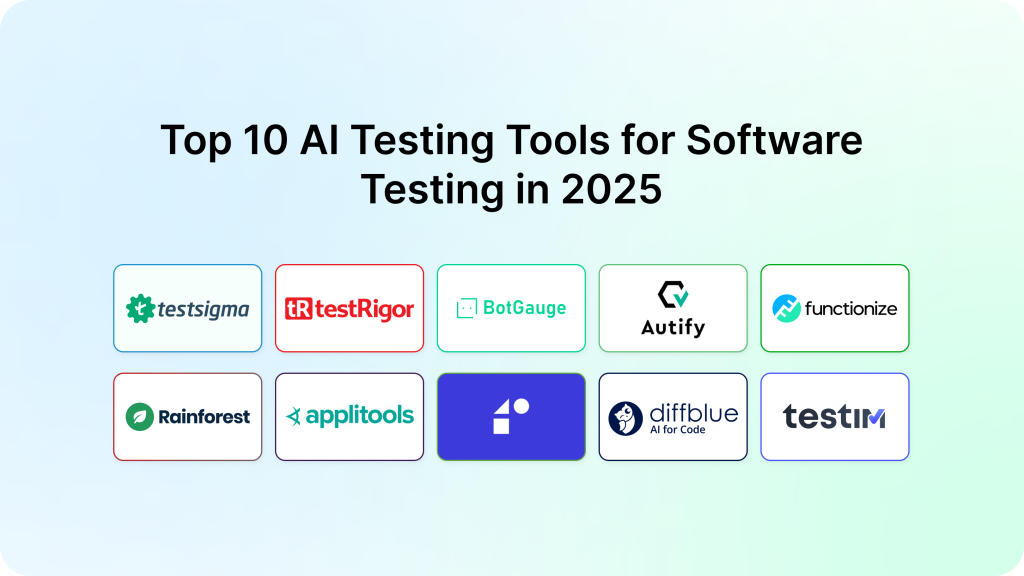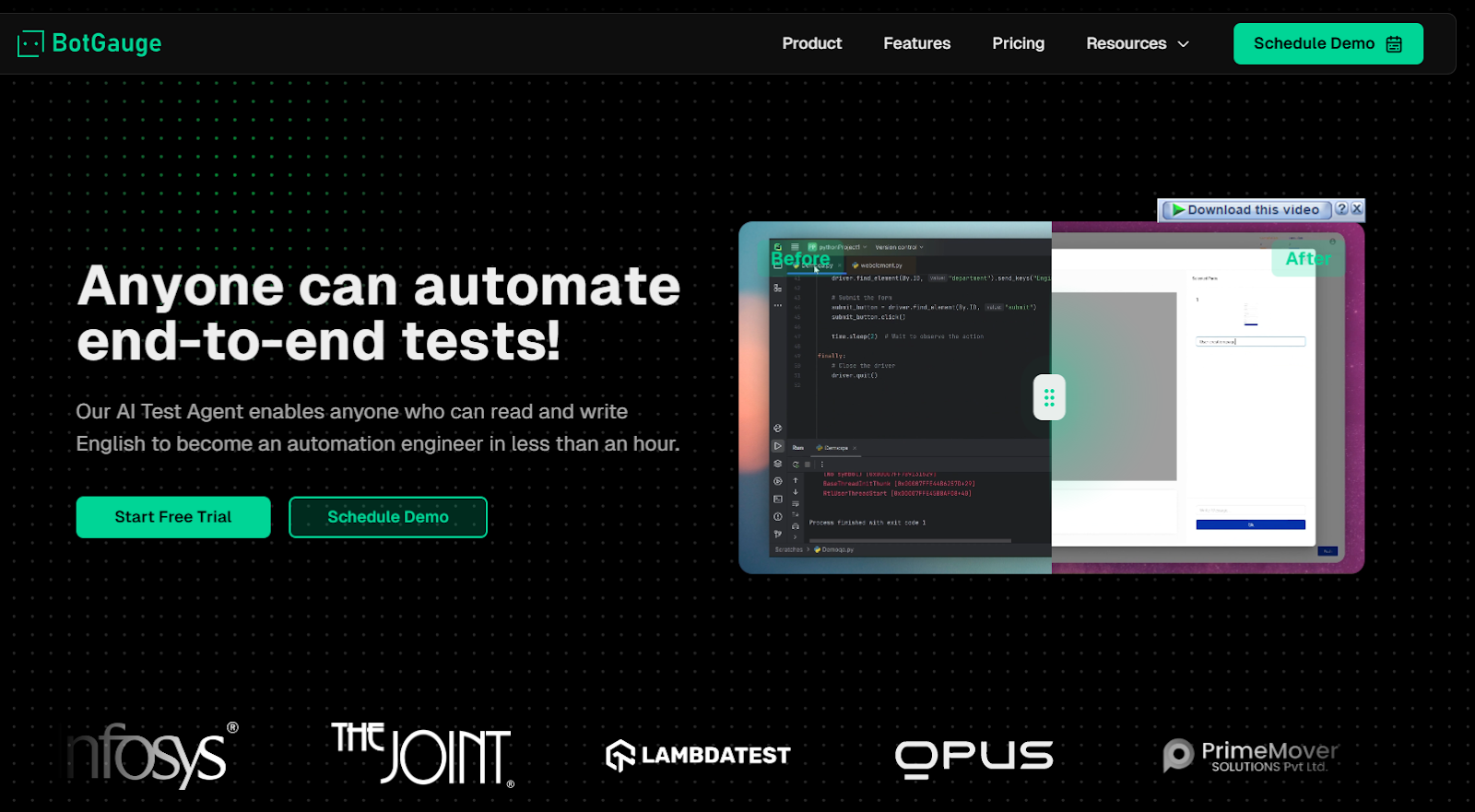Anyone can automate end-to-end tests!
Our AI Test Agent enables anyone who can read and write English to become an automation engineer in less than an hour.
Table Of Content

Table Of Content
Testing just got turbocharged. Are you ready for smarter QA in 2025? AI testing tools now help teams automate up to 80% of functional tests and uncover defects up to 90% more often than manual methods. Imagine generating full test suites in minutes, cutting test creation time by 75%, and boosting coverage by 85% — that’s not far-fedged future, it’s happening now. Could your release cycle shrink from weeks to days? What if flaky test scripts fixed themselves? This blog shows how best AI testing tools transform QA, delivering speed, reliability, and real results.
The pressure to release faster, test deeper, and fix smarter has never been higher. That’s exactly where AI testing tools step in. They’re not just accelerating test cycles—they’re rewriting the QA playbook.
Today’s AI-based platforms run tests 10× faster, execute them 24/7 in the cloud, and adapt to changes instantly. Companies using AI automation testing tools report reducing test creation time by 75% and execution time by 80%. Tools like BotGauge and Testim generate scripts directly from product documentation, skipping the manual setup altogether.
Modern apps aren’t simple anymore. Think microservices, quantum APIs, or hybrid architectures. Traditional QA breaks under this weight. With AI software testing, tools handle multi-layered systems, update locators on their own, and even flag flaky tests using predictive models. Teams are no longer chasing bugs—they’re watching AI detect and solve them before anyone notices.
| Tool | USP | Key Feature | Use Case |
| BotGauge | Zero-code full-suite testing | Auto-test from Figma/docs | Fast cross-platform QA |
| TestRigor | Plain-English test scripting | NLP-based test generation | Non-tech QA teams |
| Autify | Low-code web/mobile automation | Chrome plugin + smart updates | Agile UI teams |
| Functionize | ML-powered smart QA | Self-healing, dynamic execution | Fast-changing enterprise apps |
| Rainforest QA | No-code browser testing | Real-time test recording | Remote/startup QA |
| Applitools | Visual AI for UI testing | Pixel-perfect cross-browser checks | Design-focused apps |
| Testsigma | Cloud-based NLP testing | NLP scripting + CI/CD ready | Growing QA teams |
| Reflect | Smart recorder for web tests | Auto-steps + browser playback | UI-heavy web projects |
| Diffblue Cover | Java unit test AI | JUnit test generator | Java codebase with low coverage |
| Testim | Scalable AI test flows | Dynamic locators + healing scripts | Large teams with frequent releases |
The market is flooded with AI-based platforms, but not all deliver real results. Here’s a curated list of the best AI testing tools that are actually solving QA problems—at scale. From self-healing test scripts to autonomous test frameworks, these tools are shaping how teams test in 2025.

USP: Full-suite AI testing tool with zero-code setup.
Key Feature: Converts Figma designs, user stories, or PRDs into ready-to-run tests.
Use Case: Teams who want to automate cross-platform testing fast—without hiring engineers.
Why it matters: BotGauge’s intelligent test automation reduces QA timelines by up to 85%.
USP: Plain-English scripting with strong API and UI support.
Key Feature: NLP engine turns user flows into test cases.
Use Case: Non-technical testers who want to manage AI software testing without touching code.
Bonus: Tracks flaky test behavior over time for better reliability.
USP: Low-code web and mobile automation with smart locator healing.
Key Feature: Chrome plugin for auto-recording tests + predictive analytics testing insights.
Use Case: Agile teams needing instant feedback on frequent UI changes.
Support: Integrates with CI/CD and DevOps AI integration tools.
USP: Combines machine learning testing with visual validation.
Key Feature: Smart test maintenance and dynamic execution.
Use Case: Enterprises working with fast-changing apps.
Standout: Uses self-healing test scripts and autonomous test frameworks for scale.
USP: Entirely browser-based test authoring.
Key Feature: No installation; record and generate tests in real time.
Use Case: Remote QA teams or early-stage startups.
Add-on: Offers ethical AI validation features using synthetic test accounts.
USP: AI-driven visual testing for pixel-perfect UIs.
Key Feature: Spot UI defects across browsers, devices, and screen sizes.
Use Case: Design-centric apps where visuals are critical.
Extra: Integrates with Selenium, Cypress, and Playwright.
USP: End-to-end, cloud-based AI automation testing tool.
Key Feature: NLP scripting with CI/CD integrations.
Use Case: Mid-sized teams scaling from manual to automated testing.
Efficiency: Handles low-code AI testing needs.
USP: Test recording with smart playback across browsers.
Key Feature: Smart step insertion and easy test updates.
Use Case: Web-first teams testing UIs with fast iterations.
Note: Works well with automated test generation needs.
USP: AI for Java unit tests—no scripting needed.
Key Feature: Auto-generates JUnit test coverage.
Use Case: Java-heavy apps with low test coverage.
Integration: Plugs into GitHub, Bitbucket, and GitLab pipelines.
USP: Built for scalability with AI-based QA tools.
Key Feature: Dynamic locators and self-healing test flows.
Use Case: Large teams juggling frequent deployments.
Before picking a platform, focus on the features that matter in 2025. The best AI testing tools offer more than just automation—they deliver intelligent adaptability, ease of use, and reliable insights.
When tests fail, developers need answers. XAI dashboards highlight failure reasons, test paths, and pattern-based error clusters. These help QA teams trace root cause analysis in seconds, not hours.
Scalability is built-in. Leading AI automation testing tools automatically adjust cloud resources. If test load spikes, the tool scales infrastructure. If load drops, it scales down—saving both time and money.
Drag-and-drop workflows are now standard. Most tools support low-code AI testing, so even product managers or manual testers can create tests. Teams no longer depend solely on developers.
Bonus features include:
These features help QA teams move from just executing tests to optimizing the entire software quality process.
Adopting AI testing tools isn’t just plug-and-play. A phased rollout ensures better ROI, fewer setbacks, and faster productivity.
Start by identifying broken flows, flaky test cases, and low-coverage modules. Use analytics from your current test suite to highlight blind spots. Focus on API layers, UI paths, and failed edge scenarios.
Run initial tests on visual testing and API regression—they yield fast results. Leverage automated test generation to create scripts from product specs, saving hours of effort.
Mix automated and human testing. While AI handles routine execution, your team can focus on exploratory QA. Integrate with CI/CD to align testing with real-time deployments.
The best AI automation testing tools provide dashboards, feedback loops, and scalable plans that grow with your QA goals. But without a phased plan, even the best platform won’t succeed.
BotGauge isn’t just another AI testing tool—it’s built for speed, clarity, and real-world QA needs. Teams can generate full test suites directly from PRDs, design files, or even chat instructions using its AI automation testing tool agent. It supports UI, API, database, and integration testing without writing code.
Its strongest feature? Self-healing test scripts that automatically fix themselves when UI elements change—cutting failure rates by up to 70%. You also get detailed XAI dashboards for transparent debugging and coverage insights.
What makes BotGauge ideal for 2025? It’s one of the few tools that scales effortlessly across DevOps AI integration pipelines while remaining user-friendly. From startups doing manual testing to enterprises with full QA teams, it adapts to your workflow.
And with a cloud-first model, you can spin up scalable, cross-platform AI testing environments in minutes—keeping releases fast and stable.
Software teams no longer rely on traditional scripts and guesswork. The smartest ones use AI testing tools to run faster cycles, reduce bugs, and scale quality with fewer resources. Whether it’s self-healing test scripts, automated test generation, or low-code AI testing, the gains are real—measured in hours saved, failures prevented, and releases accelerated.
Tools like BotGauge are already proving this across industries. With proper onboarding and phased rollouts, even lean QA teams can see results in weeks. 2025 isn’t about testing harder—it’s about testing smarter. And AI automation testing tools are how smart QA gets done today.
Yes. Most AI testing tools offer encrypted synthetic data generation to protect personal or financial information, keeping your QA process compliant with GDPR and HIPAA.
Absolutely. Tools like BotGauge start at affordable prices, making advanced AI automation testing tools accessible for small teams.
Not always. Around 70% of the best AI testing tools provide zero-code or low-code interfaces, so non-developers can create and run tests easily. Coding helps with advanced customization.
Top tools report 85–92% accuracy, especially when combined with human validation and test tuning.
Skipping training. Even with intuitive platforms, teams need 2–4 weeks of onboarding to get maximum value.
Yes. Platforms like QuantumTest AI and BotGauge support cross-platform AI testing, including blockchain and quantum-native components.
Share
Curious and love research-backed takes on Culture? This newsletter's for you.
View all Blogs
Our AI Test Agent enables anyone who can read and write English to become an automation engineer in less than an hour.